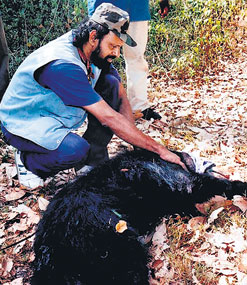As the season for sighting the Sloth Bear draws to a close, Malaka Rodrigo takes a look at this charismatic, but elusive animal now seen in only a few national parks
The sloth bear has a marked preference for Palu berries. The Palu season starts in May and goes on till end July, coinciding with the unofficial bear watching season. Yala is one of the best places to watch bears in open areas during this time as they are attracted to the fallen fruit. This year, though the palu season has not been that rich, trackers at Yala and park warden -Weragama confirmed regular bear sightings, including that of a mother bear and cubs.
Palu is a sweet fruit and bears can’t resist the temptation. They will climb the tall trees in search of these berries hanging on branches. Young greedy bears sometimes overfeed on palu and this has the effect of making them dizzy.
Last year, the palu season was in abundance and bear sightings were excellent. A foreign TV crew who filmed the documentary “Seasons of the Spirit Bear” for Animal Planet had ample opportunities of seeing these elusive creatures in Yala for two months. “The international film crew was thrilled to see the sloth bear in the Sri Lankan wilderness,” said Chitral Jayathilake, who was their Field Consultant. The film was shown around the world.
 |
| Dr. Padmalal examines a sloth bear |
With leopards and elephants becoming the key attraction in nature-based tourism, the sloth bear – another powerful carnivore in Sri Lanka’s jungles has failed to attract that much of a fan club.
Difficulties in spotting bears and the reputation that the sloth bear has earned as a notorious animal maybe some of the reasons that it hasn’t become such a popular attraction in Sri lanka.
The sloth bear is feared mainly due to its aggressiveness and unprovoked attacks. Unlike the leopard that has acute senses that help it to track a human from a distance the sloth bear relies mostly on its eyesight and realizes human presence, only when it is very close. The animal panics if it does not see a clear route of escape, and attacks as a defensive mechanism.
Childers Jayawardene, a retired park warden of Yala who has experienced many bears during his period in Yala advises that it is better not to run or show fear, if you encounter a bear. If you turn back and run after a bear has spotted you, the chances that the bear will attack are doubled. "You could pick up some sticks and make a big noise and stand your ground," Childers advises.
The unprovoked attacks on human beings mostly occur when the female is with its cubs or during the mating season when the males are aggressive. However, the bear is active mainly at night, minimizing the encounters. “Some are trying to project that there is a major bear-human conflict in the country. But bear attacks occur mainly when humans encroach on their boundaries,” Dr. U.K.G.K. Padmalal said.
Earlier, the sloth bear could be seen in many of the jungles in the dry zone. But now they are confined to a few national parks. This is mainly due to the game shooting. Even in Yala and its eastern territories, the bear was not protected until 1956. This virtually wiped out bears from some parts of the protected areas.
Wasgamuwa is said to have the largest bear population estimated at around 50 – 75 animals. Yala too is said to be inhabited by about 50 bears and Wilpattu is also a good place for watching bears. But an islandwide survey to identify the actual numbers to draft a conservation plan is a need of the hour according to the experts. IUCN – the International Union for Conservation of Nature put the sloth bear in the endangered category on their Red List and predicts it may be the first larger carnivore that we will lose.
Habitat loss is the main reason for the decline for bears as they require quality forest cover for survival. Encounters with humans are fatal for bears as well, though, they are not purposefully hunted.
Though their conservation status is critical, the sloth bear is one of the least studied animals in Sri Lanka. The first intensive study of the Sri Lankan subspecies of sloth bear was done at Wasgamuwa in 2003 by Dr. Padmalal and Dr. Shyamala Ratnayake. They radio collared 10 sloth bears to track their home ranges. State of the art camera traps are also used. The research revealed the bears in Wasgamuwa have small home ranges compared with other bear species. Most of the bears are concentrated in the middle of the park and one of the reasons for smaller home ranges is the availability of food resources.
The research team visited villages adjoining the forested habitat and interviewed villagers. Some villagers admitted to shooting sloth bears in self-defence or in fear of an imminent attack but most accepted the need of protecting bears. It is said that some collect bear fat for its supposed ability to stimulate hair growth, but no bears are killed solely for this purpose.
Visit Yala during this season and you may be lucky enough to see a sloth bear .
The sloth bear
The sloth bear can only be found in the Indian subcontinent and Sri Lanka. It is an endemic subspecies in Sri Lanka classified as Melursus ursinus inornatus. | 
